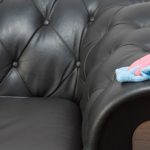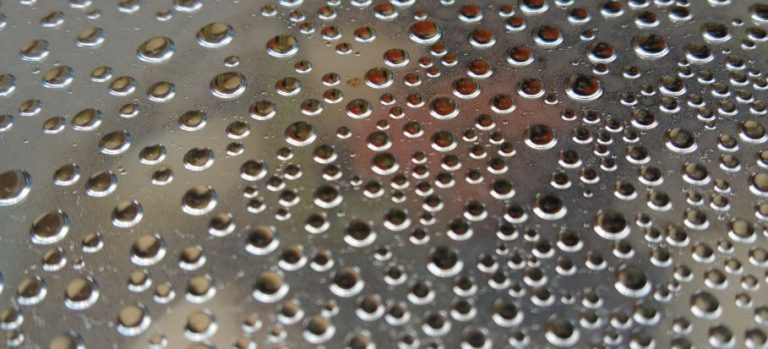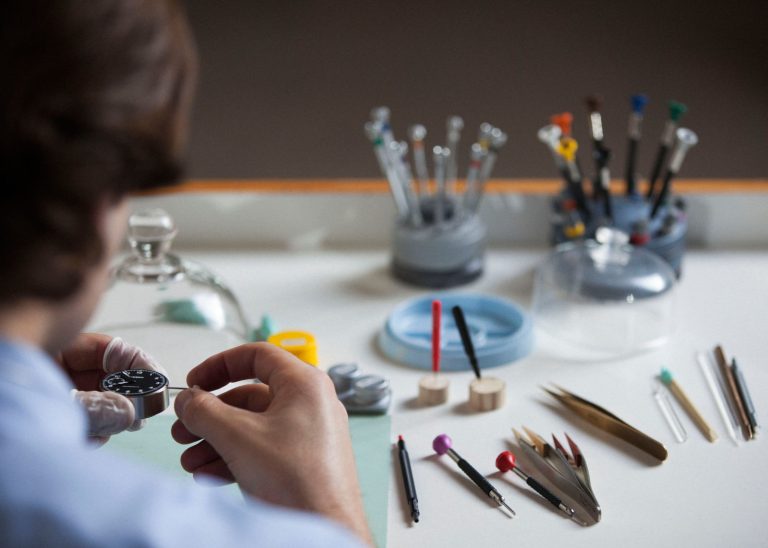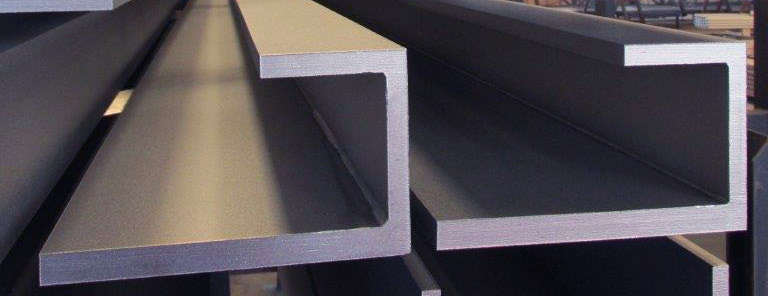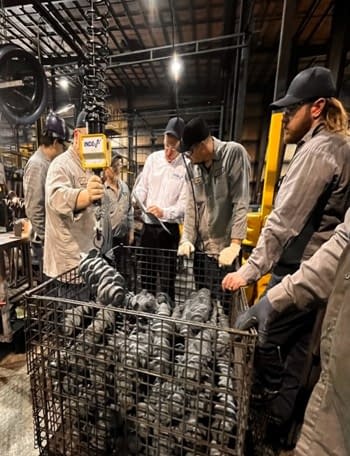How to Remove Mould from Fabric Furniture Effectively
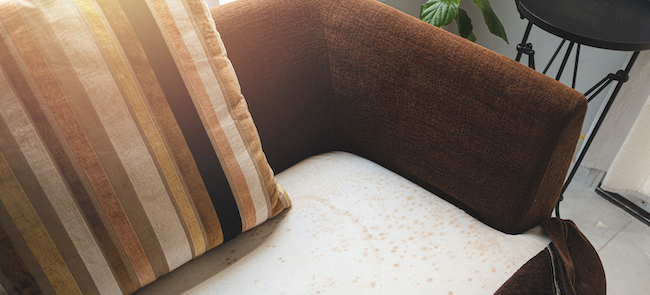
There’s nothing more terrifying than seeing a patch of mould on your favourite chair or sofa! Unfortunately, if your furniture is kept in a damp room, mould growth can occur.
Usually, mould grows in dark, humid and poorly ventilated places. Once it starts feeding on dust, dead skin cells, dirt or any other organic matter, it will continue to spread unless you undertake the right measures.
So, if you:
- Have noticed a nasty mould spot on your fabric furniture;
- Want to know how to clean mould from your upholstery yourself;
- Are searching for a homemade mould remover.
Then you are at the right spot! Keep on reading to find out how to effectively remove mould from your fabric furniture.
What causes mould on fabric furniture?
To remove mould from fabric furniture, it is essential to understand why the mould appeared in the first place, so you can treat it accordingly.
Firstly, for mould to grow it needs to have some sort of organic matter – an old food stain, some breadcrumbs underneath the cushions, dust and other foreign substances. Otherwise, it can not appear on a clean synthetic fibre.
Secondly, moisture provokes mould growth. All the dust and debris on your mattress, sofa or chair need to maintain the moisture for an extended period of time to actually form a ground for the mould to grow. This is why it is important to store your upholstery items in a dry and well-ventilated place. If the humidity levels are above 50%, then it is highly likely for mould to appear.
Commonly, homeowners store their upholstery items in plastic, to prevent them from accumulating dust over time. Whereas plastic is effective against dust, it can retain moisture. If the furniture has been slightly damp before storing, the plastic won’t allow the air to go through, leaving the items wet. And as we have already established – mould loves moisture.
If after removing mould from the furniture you need to store it, we recommend choosing a dry and ventilated room or, as an alternative, you might find it helpful to store your furniture in storage units.
Things to know before cleaning mould from upholstery
There are several things you have to remember before removing mould from fabric furniture:
- Wear protective equipment. Make sure to wear filter masks. Exposure to mould has been linked to asthma and respiratory allergies development. Extensive cleaning will lift the spores up from the surface of the furniture, so the risk of exhaling them is higher;
- Leave the furniture to dry outside. Before cleaning, it’s highly recommended to place your furniture items in the sun. Choose an area where your furniture items can stay for several hours or even a whole day. The longer you allow your furniture to air out, the more likely you are to get rid of the musty smell of furniture. If the items are too big to be carried out, disassemble them on separate elements – cushions, pillows, mattresses, etc. Once the furniture is dry, the spores won’t be able to survive on the fabric surface anymore, leaving you with just simple cleaning to do;
- Clean your upholstery outdoors. This way you eliminate the chances of the mould spores spreading indoors and spreading further;
- Do a spot test prior to cleaning. Choose a small invisible area of the fabric to test the cleaning solution of choice on any discolourations;
- Don’t attempt DIY mould cleaning if you have asthma or allergies. Seriously, don’t. Mould exposure can cause a lot of negative health effects, especially on people with conditions where you can have more intense reactions. Better trust the job to professional upholstery cleaners;
- Be ready to let go. Sometimes, the damage is more critical than we would wish it to be. Unfortunately, if your furniture item has a substantial mould presence, it will be easier to discard the item.
How to remove mould from fabric furniture with bleach
This method can be quite effective on the fabric that you know won’t get washed or fade during the cleaning process. Those are usually synthetic fibres that have been dyed in the middle of the fabric-making process. Nylon, polyester, and acrylic fabrics are some of those.
However, we still recommend performing a small spot test on a hidden part of your upholstery item before applying the bleach to the actual stain!
Here is how to remove mould from fabric upholstery with bleach:
- Add 1 cup of liquid bleach and ¼ of a cup of any mild soap to 5 litres of water;
- Apply the solution with the help of a spray bottle or a dampened solution cloth;
- Let it soak for 10 minutes;
- Wash off the solution with a clean sponge or damp cloth and leave the fabric to dry;
- Repeat the process if the staining remains visible.
6 ways to remove mould from fabric furniture without bleach
Mould can grow on many types of fabric, causing unsightly stains and odours. It is important to remove mould as soon as you notice it. Failure to do so could damage the furniture piece or make the problem even worse and spread to other items. The following methods show you how to remove mould from the home and outdoor fabric furniture yourself.
Vinegar
Vinegar is a universal cleaner that can be found in almost every kitchen. Because of its versatility and natural origins, a lot of households use it as a basic ingredient for green cleaning products. It has also proven to remove a great number of upholstery stains, including such persistent stains as spilt red wine and even pee stains.
Time needed: 15 minutes.
Because vinegar is mildly acidic, it stymies many forms of bacteria and fungus, making it a perfect cleaner for mould as well. This is how you remove mould from fabric with vinegar:
- Vacuum the stained area.
Once your furniture has aired outside enough, vacuum the stain to collect the powdery mould residue from the furniture. We recommend using an upholstery brush attachment if you have one;
- Prepare cleaning solution.
Combine water and rubbing alcohol in 1:1 proportion and, using a tapping motion, apply the mixture with a clean sponge;
- Apply onto the stain.
Next, spray some vinegar mixed with water in equal proportions on top of the stain and let the furniture piece dry outdoors.
Bear in mind, that mould can attach itself to any surface and easily spread. That is why it is better to change the used vacuum cleaner bag or wash it thoroughly. The same applies to vacuum cleaner filters and the attachment.
Lemon juice
Lemon juice acts the same way as vinegar – it’s mildly acidic and can kill mould from both porous and non-porous materials. Once the juice gets into contact with mould, it breaks it down, making it easier to remove the remaining bits of the stain.
- Pretreat the stain with a vacuum cleaner, to loosen and collect all the dry material;
- Squeeze the juice of approximately 3 lemons in a separate bowl;
- Damp cotton pads in the juice and place them over the mould stains to soak in;
- Wait for 10 minutes and remove the pads and let the spot air dry;
- Vacuum the stain once again;
- If the stain remains, you can reapply the juice and use some mild soap to remove tougher spots.
Soap
The good old soap that we use for washing and cleaning can also quite effectively remove mould stains from upholstery furniture.
- Mix some soap or a mild detergent with warm water;
- Dip a clean sponge into the solution and squeeze the sponge several times until the foam forms suds;
- With the same sponge, transfer some of the foam to the stain and let it soak;
- After 10-15 minutes, remove the soap with a clean damp cloth, and let the surface dry fully.
Hydrogen peroxide
This is another alternative method of cleaning mould from fabric furniture, as hydrogen peroxide has anti-fungal qualities. For this method, you will need a 3% hydrogen peroxide solution.
- Apply the hydrogen peroxide to the stain and let it stay for several minutes;
- Next, rinse the solution with a sponge or a damp cloth;
- Let the fabric dry fully and repeat the above step if needed.
Baking soda
Baking soda is a safe and effective alternative for cleaning upholstery and soft furnishings. It’s also safe for humans, but don’t forget to wear protective gear when doing the job.
This is how you remove mould with baking soda:
- In a spray bottle, mix 1 teaspoon of baking soda with 2 cups of warm water. Don’t forget to shake the bottle well, to mix it all up;
- Spray the mixture all over the affected area;
- Using a soft brush, gently scrub the stain;
- Take a clean damp cloth to rinse the baking soda;
- To make sure that the mould has been killed, spray some vinegar in the end.
Essential oils
Essential oils naturally have anti-fungal and anti-bacterial properties. In nature, plants produce natural oils to repel predators and pests, including mould and bacteria. Even after it’s processed for regular use, the oil still continues to be mould repellent. These oils include cinnamon essential oil, tea tree oil, lemon essential oil, peppermint essential oil, etc.
However, when treating your upholstery with essential oils, you need to remember that it’s effective only for a small affected area. The essential oil solution will not work on large quantities of mould. Additionally, it doesn’t remove mould completely, it only cleans the stains. For deep cleaning, the best solution would be to call a professional cleaning company.
So, to remove mould stains with essential oils, you need:
- Mix 40 drops of any essential oil of your choice and 1 cup of vinegar in a spray bottle;
- Shake well to mix;
- Spray the solution on the affected surface and let it sit for an hour;
- Once the time’s up, wipe the surface with a wet cloth. If the stain is still there, repeat the steps.
Professional upholstery cleaning
Mould growth can appear on the surface of your upholstery item. Unfortunately, if it’s already visible, most likely the spores have spread deeper within the furniture piece. Small spores are not visible to the naked eye, which makes the problem even harder to deal with on your own. Once you notice the problem, it’s a good idea to address it and do it the right way.
Professional upholstery cleaning is exactly the right solution for this occasion. Highly qualified specialists will pre-treat your furniture without any damage to the fabric. With a hot water extraction method, they will collect all the dust and grime from your mattress or sofa, leaving it clean as new. Additionally, the items can be treated with antiviral detergents that destroy almost all the bacteria.
If this is the solution you wish to go with, then you can check out the upholstery cleaning service by Fantastic Services! Simply type in your postcode and we will be able to give you a quote.
Need professional upholstery cleaning?
Fantastic Services is here for you!

Takeaways
- Mould is highly contagious. That is why it is better to clean your fabric furniture outside to avoid spreading it indoors;
- It is important to let your upholstery item dry in the sun before cleaning. This ensures that your furniture piece is free of moisture and eliminates chances of mould outbreaks;
- Remember, mould is dangerous and can lead to the development of respiratory diseases. Therefore, prepare protective equipment before removing mould from your fabric furniture;
- To remove mould from upholstery, you can try various DIY methods but remember that they will remove the mould only from the surface. Deeper cleaning is possible only if you have professional equipment.
***
Did you find this post helpful? Would you like to share something with our readers? Share your thoughts in the comments down below!
Image source: Shutterstock / Nor Gal
